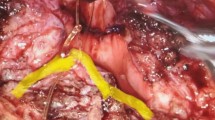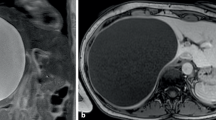Abstract
Background
Laparoscopic adrenalectomy is known to have a low complication rate; however, the influence of functional tumor subtype on postoperative outcomes is not well defined.
Methods
Patients undergoing laparoscopic adrenalectomy for benign adrenal tumors between 2009 and 2017 were selected from the American College of Surgeons National Surgical Quality Improvement Program (NSQIP) database. Patient demographics, postoperative outcomes, and length of stay were compared between tumor subtypes.
Results
A total of 3946 patients underwent a laparoscopic adrenalectomy during the study period; 3214 (81.5%) were performed for non-functional adenomas, and 732 (18.6%) for functional tumors—467 (64%) aldosteronomas, 184 (25%) cortisol-producing adenomas, and 81 (11%) pheochromocytomas. The risk of any complication was highest for patients with Cushing’s (6.5%) and lowest with Conn’s syndrome (1.1%) compared to other lesions (3.7% pheochromocytoma, 5.3% adenoma, p < 0.001). Among the patients with functional tumors, those with cortisol-producing adenomas had the highest rates of both deep surgical site infection (1.6%, p = 0.026) and urinary tract infection (2.2%, p = 0.029), whereas myocardial infarction was most prevalent in patients with pheochromocytoma (2.5%, p = 0.012). When adjusted for demographic differences, BMI, and comorbidity scores, no tumor type was associated with increased complication rate; instead aldosteronoma (vs. benign adenoma) was independently predictive of fewer adverse events [0.3 (95% CI 0.1–0.7), p = 0.004] and a shorter length of hospital stay [0.6 (95% CI 0.4–0.8), p = 0.001]. The overall mortality rate was low at 0.4%, although significantly higher in Cushing’s patients (2.2%, p = 0.015).
Conclusions
Laparoscopic adrenalectomy is a safe operation with low mortality and complication rates. However, postoperative risks differ between tumor subtype, so patients should be counseled accordingly.

Similar content being viewed by others
References
Elfenbein DM, Scarborough JE, Speicher PJ, Scheri RP (2013) Comparison of laparoscopic versus open adrenalectomy: results from American College of Surgeons-National Surgery Quality Improvement Project. J Surg Res 184:216–220
Lee J, El-Tamer M, Schifftner T et al (2008) Open and laparoscopic adrenalectomy: analysis of the National Surgical Quality Improvement Program. J Am Coll Surg 206:953–959
Eichhorn-Wharry LI, Talpos GB, Rubinfeld I (2012) Laparoscopic versus open adrenalectomy: another look at outcome using the Clavien classification system. Surgery 152:1090–1095
Gaujoux S, Bonnet S, Leconte M et al (2011) Risk factors for conversion and complications after unilateral laparoscopic adrenalectomy. Br J Surg 98:1392–1399
Gupta PK, Natarajan B, Pallati PK et al (2011) Outcomes after laparoscopic adrenalectomy. Surg Endosc 25:784–794
Conzo G, Gambardella C, Candela G et al (2018) Single center experience with laparoscopic adrenalectomy on a large clinical series. BMC Surg 18:2
Chen Y, Scholten A, Chomsky-Higgins K et al (2018) Risk factors associated with perioperative complications and prolonged length of stay after laparoscopic adrenalectomy. JAMA Surg 153:1036–1041
Limberg J, Ullmann TM, Gray KD et al (2019) Laparoscopic adrenalectomy has the same operative risk as routine laparoscopic cholecystectomy. J Surg Res 241:228–234
Smith CD, Weber CJ, Amerson JR (1999) Laparoscopic adrenalectomy: new gold standard. World J Surg 23:389–396
Beck AC, Goffredo P, Hassan I et al (2018) Risk factors for 30-day readmission after adrenalectomy. Surgery 164:766–773
Bergamini C, Martellucci J, Tozzi F, Valeri A (2011) Complications in laparoscopic adrenalectomy: the value of experience. Surg Endosc 25:3845–3851
Kim AW, Quiros RM, Maxhimer JB et al (2004) Outcome of laparoscopic adrenalectomy for pheochromocytomas vs aldosteronomas. Arch Surg 139:526–529
Babic B, De Roulet A, Volpe A, Nilubol N (2019) Is VTE prophylaxis necessary on discharge for patients undergoing adrenalectomy for cushing syndrome? J Endocr Soc 3:304–313
Fernández-Cruz L, Sáenz A, Benarroch G et al (1996) Does hormonal function of the tumor influence the outcome of laparoscopic adrenalectomy? Surg Endosc 10:1088–1091
Kiernan CM, Shinall MC, Mendez W et al (2014) Influence of adrenal pathology on perioperative outcomes: a multi-institutional analysis. Am J Surg 208:619–625
Toniato A, Boschin I, Bernante P et al (2007) Laparoscopic adrenalectomy for pheochromocytoma: is it really more difficult? Surg Endosc 21:1323–1326
Anon https://www.facs.org/quality-programs/acs-nsqip/participant-use. Accessed 14 Nov 2018
Raval MV, Pawlik TM (2018) Practical guide to surgical data sets: national surgical quality improvement program (NSQIP) and pediatric NSQIP. JAMA Surg 153:764–765
Subramaniam S, Aalberg JJ, Soriano RP, Divino CM (2018) New 5-factor modified frailty index using American College of Surgeons NSQIP Data. J Am Coll Surg 226:173–181
Anderson JE, Seib CD, Campbell MJ (2018) Association of patient frailty with increased risk of complications after adrenalectomy. JAMA Surg 153:966–967
Traven SA, Reeves RA, Sekar MG et al (2019) New 5-factor modified frailty index predicts morbidity and mortality in primary hip and knee arthroplasty. J Arthroplasty 34:140–144
Sommerey S, Foroghi Y, Chiapponi C et al (2015) Laparoscopic adrenalectomy–10-year experience at a teaching hospital. Langenbecks Arch Surg 400:341–347
Anon. https://www.ingentaconnect.com/content/sesc/tas/2014/00000080/00000011/art00033%3bjsessionid=d0d5lg55ahjh8.x-ic-live-03. Accessed 15 Feb 2019
Wierdak M, Sokołowski G, Natkaniec M et al (2018) Short- and long-term results of laparoscopic adrenalectomy for Conn’s syndrome. Wideochir Inne Tech Malo Inwazyjne 13:292–298
Henry JF, Defechereux T, Raffaelli M et al (2000) Complications of laparoscopic adrenalectomy: results of 169 consecutive procedures. World J Surg 24:1342–1346
Dancea HC, Obradovic V, Sartorius J et al (2012) Increased complication rate in obese patients undergoing laparoscopic adrenalectomy. JSLS 16:45–49
Kazaure HS, Roman SA, Sosa JA (2011) Obesity is a predictor of morbidity in 1629 patients who underwent adrenalectomy. World J Surg 35:1287–1295
Brunaud L, Nguyen-Thi P-L, Mirallie E et al (2016) Predictive factors for postoperative morbidity after laparoscopic adrenalectomy for pheochromocytoma: a multicenter retrospective analysis in 225 patients. Surg Endosc 30:1051–1059
Gaujoux S, Bonnet S, Lentschener C et al (2016) Preoperative risk factors of hemodynamic instability during laparoscopic adrenalectomy for pheochromocytoma. Surg Endosc 30:2984–2993
García MIDO, Palasí R, Gómez RC et al (2019) Surgical and pharmacological management of functioning pheochromocytoma and paraganglioma. In: Mariani-Costantini R (ed) Paraganglioma: a multidisciplinary approach. Codon Publications, Brisbane
Schreiner F, Anand G, Beuschlein F (2019) Perioperative management of endocrine active adrenal tumors. Exp Clin Endocrinol Diabetes 127:137–146
Funding
The authors report no disclosures or financial support for this work.
Author information
Authors and Affiliations
Corresponding author
Ethics declarations
Disclosures
Dr. Zarnegar is a paid consultant for BDI Surgical, Becton Dickinson and Company. Drs. Limberg, Stefanova, Ullmann, Thiesmeyer, Buicko, Finnerty, Fahey, and Beninato have no conflicts of interest or financial ties to disclose.
Additional information
Publisher's Note
Springer Nature remains neutral with regard to jurisdictional claims in published maps and institutional affiliations.
Meeting presentation
This analysis was presented as a quick-shot oral presentation at the annual American College of Surgeons meeting in October, 2019 in San Francisco, CA.
Rights and permissions
About this article
Cite this article
Limberg, J., Stefanova, D., Ullmann, T.M. et al. Not all laparoscopic adrenalectomies are equal: analysis of postoperative outcomes based on tumor functionality. Surg Endosc 35, 2601–2606 (2021). https://doi.org/10.1007/s00464-020-07678-2
Received:
Accepted:
Published:
Issue Date:
DOI: https://doi.org/10.1007/s00464-020-07678-2




